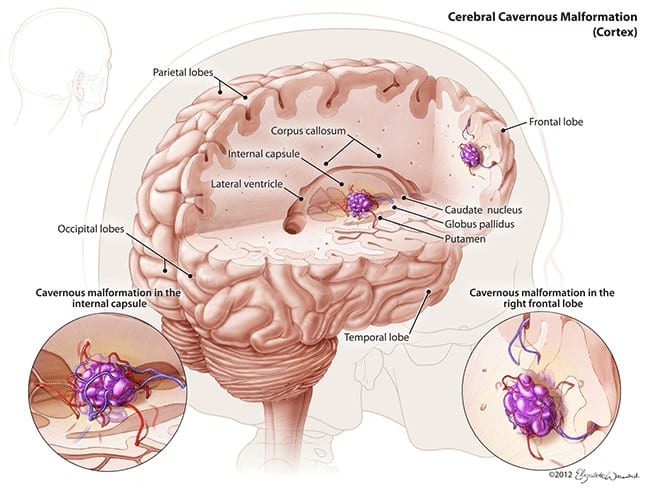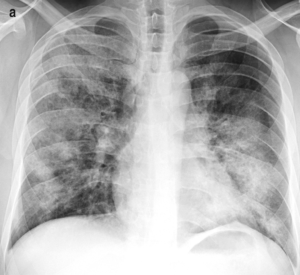A cerebral cavernous malformation (CCM) is a vascular abnormality of the brain characterized by a collection of irregular small blood vessels called the capillaries in the brain or spinal cord that leads to alteration of blood flow.
- It is also known as cavernoma, cavernous angiomas, or intracranial vascular malformation.
- It is a progressive and non-cancerous lesion of the central nervous system.
- The size of the irregularly clustered blood vessels varies from less than one-quarter inch to 3-4 inches.
- 25 percent of people with CCM do not experience any medical problems. Many people do not know they have a CCM.
- They usually only cause serious signs and symptoms when they occur in the central nervous system.
- CCM may cause serious neurological problems, such as intracerebral hemorrhage and stroke which may lead to death as a result of bleeding or severe pressure effect on the brain and nerves of the central nervous system.
Epidemiology
- Incidence: CCMs occur in about 1 in 100 to 200 people, which is around 0.5% of the general population.
- Age: 2nd to 5th decades of life. About 25% occur in children before birth or shortly after.
- There is no preference for male or female gender.

Pathophysiology
- In CCM disease, the walls of the capillaries become abnormally thinner, dilated, and less elastic due to lack of support tissues, such as elastic fibers. The blood vessels are prone to leaking with surrounding hemosiderin deposition.
- When these fragile capillaries fill with slow-moving or stagnant blood, they stretch out to create “caverns.” and may not return to their normal size when the blood vessels become empty.
- Histologically, the cluster of CCMs resembles a “mulberry-like” or “raspberry” cluster.
Causes of CCM disease
- Approximately 20% are Familial
- About 80% are Sporadic
- No clear reason has been found yet
- Sporadic CCMs are asymptomatic and usually have a single lesion
Signs and symptoms
- The majority of the lesions are asymptomatic throughout life and are found incidentally.
- Symptoms usually occur when there is serious bleeding into the central nervous system. Presentations include:
- Seizures (most common)
- Severe non-specific headaches
- Numbness
- Weakness
- Paralysis
- Hearing changes
- Loss of vision / Double vision
- Difficulty speaking or understanding speech
- Unsteadiness or balancing problem
- Bleeding in the brain (cerebral hemorrhage)
Differential Diagnosis
- Cerebral amyloid angiopathy
- Chronic hypertensive encephalopathy
- Diffuse axonal injury (DAI)
- Cerebral vasculitis
- Radiation-induced vasculopathy
- Hemorrhagic cerebral metastases
- Hemorrhagic primary brain tumors (e.g. ependymoma, glioblastoma)
Investigations
- CCMs are angiographically occult vascular malformations meaning they are not visible on an angiogram because blood flows through these lesions very slowly.
- Magnetic Resonance Imaging (MRI) of the brain is the investigation of choice
- To exclude other causes-
- CT scan
- Electroencephalogram
- Gene testing
- Blood tests
Management of CCM disease
The management of CCMs is based on the location of the lesion, severity of hemorrhage, or neurologic deficits.
- Conservative management:
- Observation with MRI scan at regular intervals to assess the stability of the lesion. CCM lesions appear and disappear over time on follow-up MRI scans.
- Closely monitoring the symptoms.
- Antiepileptic drugs to control seizures.
- Surgical removal of the lesion(s):
- Types of surgery include:
- Neurosurgery – complete removal of the lesion to prevent further hemorrhage in the future.
- Stereotactic radiosurgery- a single concentrated dose of radiation is given directly at the cavernoma, making it thickened and scarred.
- Indications of surgery:
- When the lesion is causing recurrent seizures that cannot be controlled through medications.
- When the cavernous malformation is located in a low risk and easily accessible area of the brain.
- Types of surgery include:
Prognosis
- The prognosis for CCM disease is variable in each individual as the size, location, and number of lesions determine the severity of the disease.
- CCM can be fatal, particularly when there are severe brain hemorrhages.
Complications
- Recurrent bleeding
- Seizures
- Progressive neurological deficit
- Stroke
- Malformations in the brainstem
- Death, if left untreated
Please write to us in the comment section if you have liked the article. Check our services.



